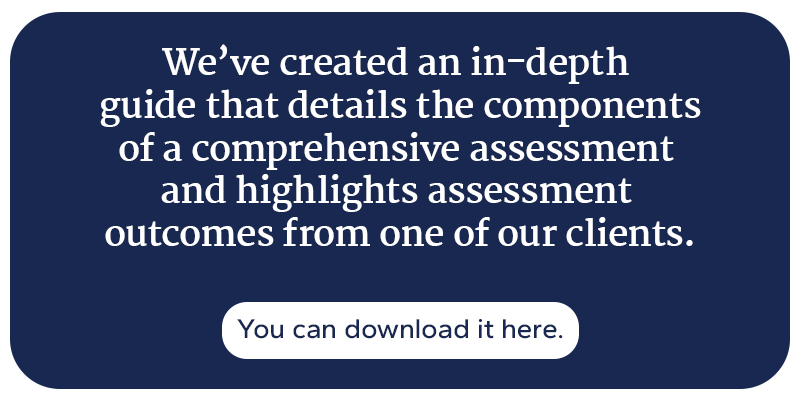Key Takeaways
- Reviewing business processes is essential to reducing waste and increasing efficiency.
- A comprehensive, 360-degree assessment of your organization — including your people, processes, applications, IT operations and infrastructure, security, and data — can help you identify areas for improvement.
- Change management is a vital component of improving process efficiency.
As your organization scales and evolves, managing business processes becomes increasingly complex. Business leaders are so busy keeping things running that there’s little time left to review processes. This oversight leads to a continuous cycle of wasting time and resources.
Process improvement isn’t just for internal optimization — it’s also about making sure you are providing quality products, customer experiences, and vendor relations.
Identifying Inefficient Business Processes
The first (and simplest) way to evaluate your processes is through communication. Gathering a cross-functional group allows you to identify how processes really work and outline inefficiencies.
For example, your operations department may not realize that the finance department uses inventory reports to make strategic business decisions. It’s natural for information to become siloed — teams are focused on individual initiatives and lose sight of how interconnected business processes really are. Another way to weed out inefficiencies is to visualize your processes with a strategic process map, like a swim lane diagram. This can help you identify bottlenecks and redundancies.
Conduct a Comprehensive Business Assessment
There is a misconception that technology and automation are quick fixes for streamlining processes. However, your digital processes can be just as inefficient as your people-driven processes. People and technology are inextricably linked; you can’t talk about one without talking about the other.
It’s important to analyze how technology is used to support your key business processes and strategic needs. Start thinking from an improvement mindset by focusing on these key areas:
- People
- Business Processes
- Business Applications
- IT Ops & Infrastructure
- Data & AI
- Security
Once you’ve completed a business and technology evaluation, you can dive even deeper by asking yourself the following questions:
- Do you use multiple systems to track your projects, accounting, inventory, and financial reports? Do these systems talk to one another?
- Are there manual processes performed outside of those systems for tracking or reporting? How are they managed, how often are they updated, and how many team members are involved?
- Is there an overlap of efforts to track these processes across roles, teams, departments, or locations?
- Are you able to see the data you need in real-time?
- How often do you use your financial reporting? How long does it take to get the final product? Can you trust the numbers being reported?
- Is your technology able to scale as your business changes?
Improving Business Processes: A Case Study
It’s tempting to review processes on a department-by-department basis, but true organizational improvement requires a holistic approach. Choose a department to start with and work your way outward, examining how each department functions individually as well as how each department interacts and shares information with others.
For example, in an examination of the accounting and finance function of one of our clients, we found inefficiencies in the AP invoice processes, including:
- Invoices needing investigation
- Item receipts not completed prior to invoice receipt
- Missing information on purchase orders/receiving
- Methods of recording freight
- Challenges with staggered shipping
These problems were a result of inefficiencies in other departments. This led to a review of the purchasing and receiving processes, aiming to identify efficiencies and reduce the workload for the accounting and finance team.
Our client had over 50 employees with purchasing cards, a large number of invoice-approvers, and a very decentralized purchasing philosophy. We determined that a more centralized approach to purchasing would simplify purchasing functions, streamline invoice workflow and approvals, and provide for better vendor management — as well as leverage the organization’s buying power and any volume pricing benefits.
We also discovered that the client could utilize functions in their business management software to streamline their processes. By implementing an added module to their existing ERP, the client would be able to easily onboard vendors and track their performance, automate tedious tasks, improve collaboration, and, overall, make their jobs easier.
Once you’ve identified your inefficiencies, the first step to process improvement is change management. Whether you’re restructuring your teams, replacing outdated systems, upgrading your IT, or even implementing a whole new technology stack, the digital demand on your business is felt most acutely by your people.
People + Processes + Technology = Sustained Success
Your people, processes, and technology each play a vital role in your success. Remove one and your project no longer captures the full scope of your business.
Employee buy-in of organizational changes can make or break your project. Follow these four guidelines for a successful change management plan in your business:
- Listen to Concerns: Acknowledge those who oppose change and hear out their concerns. It’s also important to pay attention to your frontline staff during times of change. Organizations often look to management to represent the interests of their teams, but your frontline is the face of your organization. The morale and input of this group make them essential to your change management plans.
- Promote Optimism: Listen to and amplify the excitement of your project’s biggest fans. Welcome their enthusiasm and encourage them to be your “on-the-ground” promotional squad. By empowering this unofficial group of early adopters to use their voices, you present the naysayers and neutral team members with genuine, unsolicited opinions to help reshape their perspectives.
- Actively Engage: Some leaders like to let the organization chart its own course through change. But actively partaking in the change management process allows you to influence the outcome — and steer the ship when needed. A great way to guide the project’s path is by doing an activity with your team. Whether it’s a walkthrough of a process in which each team member represents a step in the workflow, or a simple, collaborative whiteboarding session, the activity should show the action, the direction, and the vision. The goal is to foster a cohesive team that is on the same page about what the problem is, how you are addressing it, and why the change is necessary and positive.
- Keep Moving Forward: There will be bumps along the way. Acknowledge them, and then get back to work. Always keep an open mind to varying perspectives, opinions, and learning styles. But even more importantly, stick to your defined goal. Do not falter on the core objective. Of the change management plans that fail, 48% were because of lack of follow-through. Fully embrace the change — and everything that comes with it — and engage your team along the way.
Move Forward with Confidence
If you don’t have the time to devote to a process improvement analysis, we can help. Eide Bailly has a specialized team devoted to providing solutions to your business challenges. We can help you identify areas in your organization that need attention, prioritize business and technology initiatives, and create a digital roadmap that supports your business objectives.
Unlock Opportunity with a 360°Assessment

Strategy and Digital Future
Create a lasting digital future for your organization.
Who We Are
Eide Bailly is a CPA firm bringing practical expertise in tax, audit, and advisory to help you perform, protect, and prosper with confidence.




